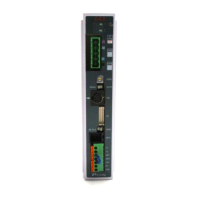163
Abnormal operation results when the servo is turned ON after the power ON.
Cause: Excitation phase detection was not performed correctly when the servo was turned ON,
because one of the following conditions existed when the power was input:
[1] The slider or rod was contacting the mechanical end.
[2] The load was being pushed by a strong external force.
Action: [1] Check if the slider or rod is contacting the mechanical end.
If the slider/rod is contacting the mechanical end, move it away from the mechanical end.
If the actuator is equipped with a brake, move the slider/rod after turning ON the brake
release switch to forcibly release the brake.
At this time, exercise caution not to allow the load to drop suddenly due to its own weight.
Your hand may be caught by the dropped load or the robot hand or load itself may be
damaged.
If the actuator cannot be moved by hand, one possible solution is to check the direction of
excited-phase signal detection and change the direction if necessary. If you wish to use
this method, consult IAI beforehand.
For details, refer to the applicable parameter in 8.2.2, “Parameters Relating to Actuator
Operating Characteristics.”
[2] Check if the load is contacting any surrounding part.
If the load is contacting any surrounding part, provide a clearance of 1 mm or more from
the applicable part.
If the checks in [1] and [2] did not find any problem, please contact IAI.
The SV lamp blinks.
The automatic servo-off mode is active. (This is not an error or fault.)

